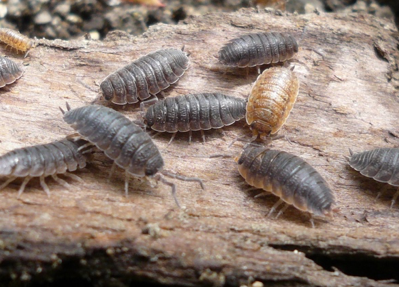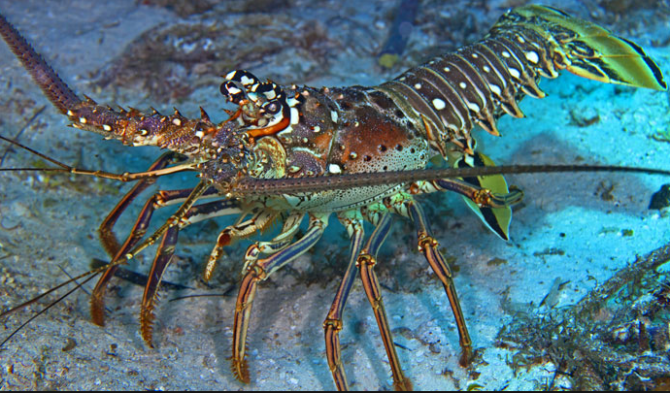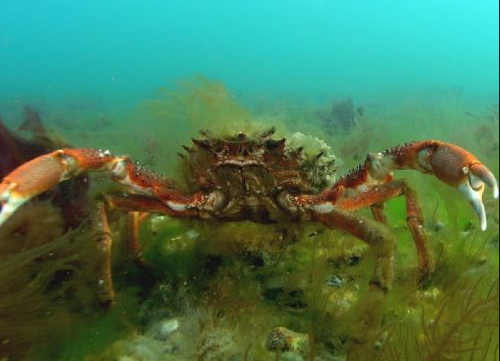Ghost Crab

Ghost crabs are semiterrestrial crabs of the subfamily Ocypodinae. They are common shore crabs in tropical and subtropical regions throughout the world, inhabiting deep burrows in the intertidal zone. They are generalist scavengers and predators of small animals. The name “ghost crab” derives from their nocturnality and their generally pale coloration. They are also sometimes called sand crabs, though the name refers to various other crabs that do not belong to the subfamily.
Characteristics of the subfamily include one claw being larger than the other, thick and elongated eyestalks, and a box-like body. The differences in claw sizes, however, are not as marked as in male fiddler crabs. The subfamily includes 22 species in two genera.
Caribbean Hermit Crab

The Caribbean hermit crab, Coenobita clypeatus, also known as the soldier crab, the West Atlantic crab, the tree crab, and the purple pincher (due to the distinctive purple claw), is a species of land hermit crab native to the west Atlantic, Bahamas, Belize, southern Florida, Venezuela, the Virgin Islands and the West Indies. Adults burrow and hide under the roots of large trees, and can be found a considerable distance inland.
Caribbean hermit crabs are both herbivorous and scavengers.[not in citation given] In the wild, C. clypeatus feeds on animal and plant remains, overripe fruit, and feces of other animals, including the Mona ground iguana, Cyclura stejnegeri. The West Indian top snail (Cittarium pica) shell is often used for its home, and the hermit crab can use its larger claw to cover the aperture of the shell for protection against predators. Typically, the Caribbean hermit crab’s left claw is larger in size than its right claw and is purple in color. Female land hermit crabs release fertilized eggs into the ocean. The spawning (called “washing” in the English-speaking Caribbean) occurs on certain nights, usually around August.
Woodlice

A woodlouse (plural woodlice) is a terrestrial isopod crustacean with a rigid, segmented, long exoskeleton and fourteen jointed limbs. Woodlice mostly feed on dead plant material, and they are usually active at night. Woodlice form the suborder Oniscidea within the order Isopoda, with over 5,000 known species.
Woodlice in the genus Armadillidium and in the family Armadillidae can roll up into an almost perfect sphere as a defensive mechanism, hence some of the common names such as pill bug or roly-poly. Most woodlice, however, cannot do this.
Spiny-Lobster

Spiny lobsters, also known as langustas, langouste, or rock lobsters, are a family (Palinuridae) of about 60 species of achelatecrustaceans, in the Decapoda Reptantia. Spiny lobsters are also, especially in Australia, New Zealand, South Africa, and the Bahamas, sometimes called crayfish, sea crayfish, or crawfish (“kreef” in South Africa), terms which elsewhere are reserved for freshwater crayfish.
Although they superficially resemble true lobsters in terms of overall shape and having a hard carapace and exoskeleton, the two groups are not closely related. Spiny lobsters can be easily distinguished from true lobsters by their very long, thick, spiny antennae, by the lack of chelae (claws) on the first four pairs of walking legs, although the females of most species have a small claw on the fifth pair,[ and by a particularly specialized larval phase called phyllosoma. True lobsters have much smaller antennae and claws on the first three pairs of legs, with the first being particularly enlarged.
Spiny lobsters have typically a slightly compressed carapace, lacking any lateral ridges. Their antennae lack a scaphocerite, the flattened exopod of the antenna. This is fused to the epistome (a plate between the labrum and the basis of the antenna). The flagellum, at the top of the antenna, is stout, tapering, and very long. The ambulatory legs pereopods end in claws chelae.
Spiny-Spider Crab

Maja squinado (the European spider crab, spiny spider crab or spinous spider crab) is a species of migratory crab found in the north-east Atlantic and the Mediterranean Sea.
M. squinado feeds on a great variety of organisms, with seaweeds and molluscs dominating in winter, and echinoderms such as sea urchinsand sea cucumbers in summer.
Migrations generally take place in autumn, with some crabs covering over 100 miles (160 km) in eight months. All crabs are vulnerable to predation when moulting, and M. squinado becomes gregarious around that time, presumably for defense against predators. Females can produce up to four broods per year.
Arrow Crab

The body of S. seticornis is triangular, and the rostrum is drawn out into a long point with serrate edges. The legs are also long and thin, up to 10 cm (3.9 in) across, and the animal’s carapacemay be up to 6 cm (2.4 in) long. Colouration is variable in this species; the body may be golden, yellow or cream, marked with brown, black or iridescent-blue lines; the legs are reddish or yellow, and the claws are blue or violet.
Stenorhynchus seticornis is found in the western and eastern Atlantic Ocean, from North Carolinaand Bermuda to Brazil, including throughout the Caribbean Sea, also in the coastal waters of Cape Verde. It lives on coral reefs at depths of 10–30 feet (3.0–9.1 m).
S. seticornis is nocturnal and territorial. It eats small feather duster worms and other coral reef invertebrates. This crab is commonly kept in reef aquariums to control bristle wormpopulations.
S. seticornis is one of a number of different invertebrates that are found living in association with the sea anemone, Lebrunia danae. It is often found among the anemone’s pseudotentacles along with Pederson’s cleaning shrimp (Ancylomenes pedersoni) and the spotted cleaner shrimp (Periclimenes yucatanicus).
During mating, the male places a spermatophore on the female, which she uses to fertilise her eggs. These fertilised eggs are then carried on the female’s pleopods until they are ready to hatch into zoea larvae. These swim towards the ocean surface and feed on plankton. They grow through a series of moults, and eventually metamorphose into the adult form.